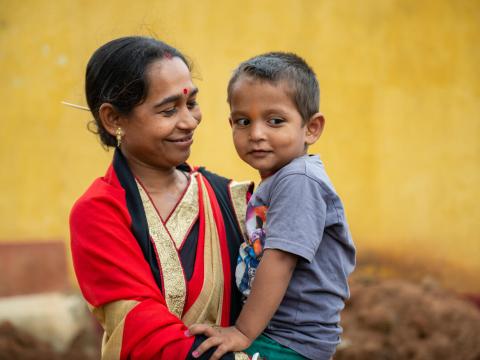Cooking demonstrations to curb malnutrition in India

Four-year-old Harsh and his mother, Bindoo, sit on a mat with other local women and children.
He cranes his head to check out the food items placed on the table. Around 40 mothers are gathered to attend World Vision India’s cooking demonstration.
Here, mothers learn to prepare nutritious food, such as healthy drinks, cereals, besan ladoo (sweets made from black chickpea flour), omelette, dal parantha, suji halwa and khijari using locally-available vegetables like wheat, barley and maize.
Mothers learn the nutritional importance of serving three colours of food - green, yellow and white - to their children.
Bindoo is one of 73 health volunteers who have received cooking training from World Vision India. Since then, Bindoo and these volunteers have trained women in 75 communities of Bokaro District.

The training is done on a quarterly basis, and parents of children with Severe Acute Malnutrition (SAM) and Moderate Acute Malnutrition (MAM) are high priority.
Mid-Upper Arm Circumference (MUAC) measurement is taken for all children. MUAC tape is a small tricolour indicator that helps determine malnutrition. Measurements are only taken on the left arm of a child. If the measurement shows red, it is a sign of Severe Acute Malnutrition (SAM). If it reads yellow, it means Moderate Acute Malnutrition (MAM). Green is a safe zone.
At two and half years old, Harsh was diagnosed with Moderate Acute Malnutrition. His MUAC indicator was in the yellow category and he weighed 11kg. Within six months of his mother receiving the training, Harsh was in the safe zone.
“I attended the training and applied those learnings at home. I learned to make cereals, ladoo, suji halwa, vegetable omelette, Horlicks and dal paratha. Within six months, Harsh's health improved tremendously and he weighed above 13kg,” Bindoo tells us.

According to the Ministry of Health and Family Welfare’s National Family Health Survey, 2015-16 (NFHS-4), almost half (45.3%) of Jharkhand’s children below the age of five are stunted, compared to the national average of 38.4%. Again, almost half (47.8%) of Jharkhand’s children are underweight, placing Jharkhand behind only Bihar and Madhya Pradesh in child malnutrition levels.
False beliefs and practices contributed to malnutrition at Kurmidih and other communities in Bokaro, Jharkhand. Here, newborn babies are not fed their mother’s milk because of the false belief held that the first milk is harmful for the baby.
Instead, children are fed cow's and goat's milk, This is contrary to World Health Organization’s recommendation that babies be breastfed exclusively for six months.
According to a report by UNICEF, exclusive breastfeeding for the first six months of a child’s life, and continued breastfeeding until age two or longer, has the potential to prevent more than 800,000 deaths in children under age five, and 20,000 deaths in women every year.

Breastfed children are also less likely to get diarrhoea and pneumonia and are 14 times more likely to survive than non-breastfed children.
At Kurmidih, most mothers stopped breastfeeding their children after a couple of months because they stopped producing milk. Malnutrition is more common among children whose mothers married young.
Many mothers are themselves anaemic, making their children more vulnerable to health hazards. Around 67.3% of women aged between 15-49 years and 71.5% of children aged between six and 59 months in rural Jharkhand are anaemic, according to the NFHS, compared to national averages of 53.1% and 58.6%, respectively.
Another major factor contributing to malnutrition is ignorance.

“Children are only fed khichdi (rice and lentils cooked together) for lunch and dinner. We encourage them to use locally-available vegetables in their cooking. Here, parents don’t feed solid food until they are a year old. We teach them to start feeding solid food after six months,” says World Vision India health volunteer, Bina.
“Villagers don’t want to go to the hospital at all, even when they are unwell. They don’t want to take their children to health centres. We give awareness messages on the importance of health check-ups and institutional delivery,” she adds.
At the cooking demonstration, women ground green peas, dal and groundnuts into fine powder on a stone mortar as children circle around the table expecting a treat. Their hope is rewarded as the programme ends in a mini-community feast of the prepared food. All these mothers say their children love the food supplement and they have seen improved health.

Apart from the cooking demonstrations, these health volunteers give timely and target counselling for expectant and young mothers. Counselling is given at various stages of the pregnancy: 2-4 months, 4-6 months and 7-9 months.
Priyanka started attending the counselling sessions when she was six months pregnant. She gave birth to a healthy baby girl, Pranjali, now 2 years old.
“I learned about the importance of eating healthy food, taking good rest and going for regular walks. Pranjali is in the green zone. She likes to eat green vegetables and also loves halwa,” says Priyanka.
World Vision India is working towards training 3,500 mothers in each quarter.